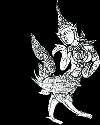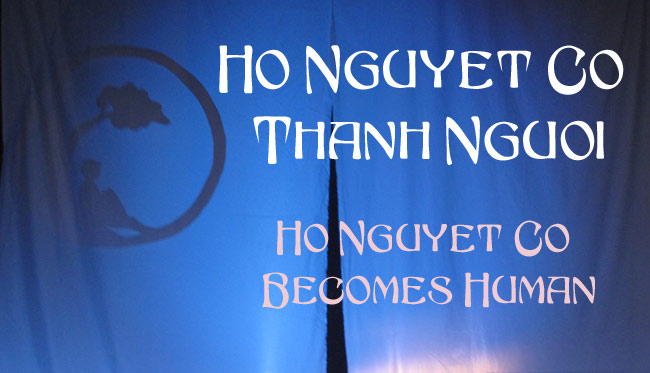These play scripts performed by KETEP are freely available. Users may also adapt them to their specific circumstances. The original plays are offered in English along with their translations in various Southeast Asian languages. Please contact Catherine Diamond: ketepinro@gmail.com.
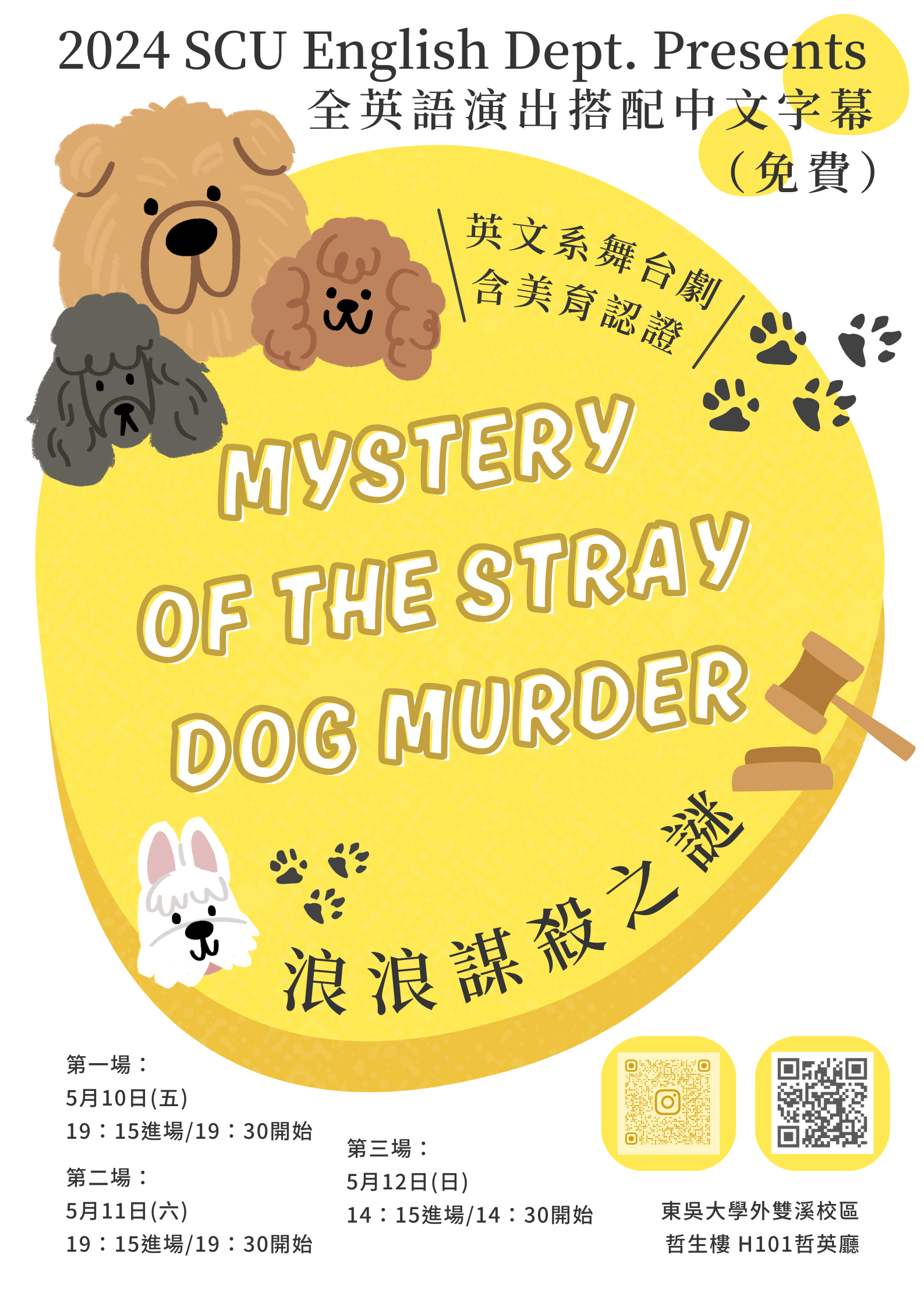 Photo Album |
The Mystery of the Stray Dog Murder 《流浪狗謀殺案》Soochow University, Taipei, Taiwan |
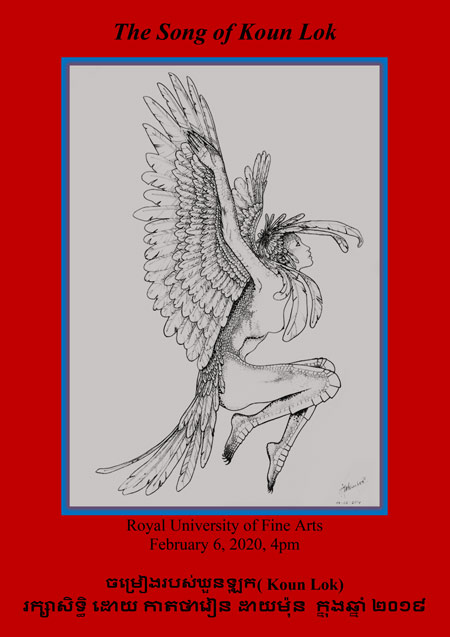 Photo Album |
The Song of Koun Lok, Royal University of Fine Arts, |
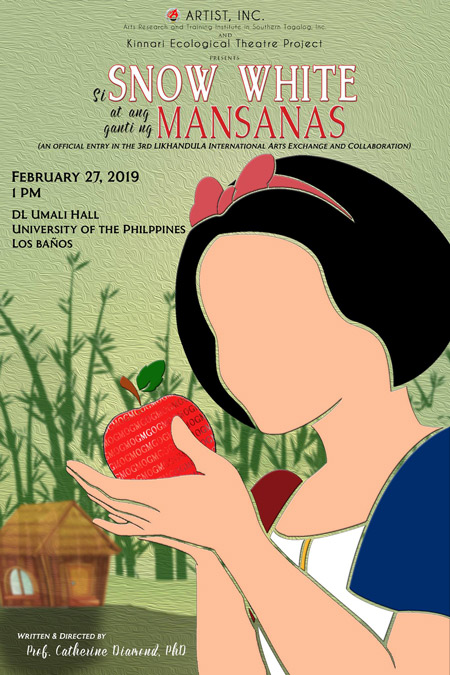 Photo Album |
Snow White and the Apple’s Revenge: Si Snow White at ang ganti ng Manasanas, Artist Inc. Likhandula Festival, Los Baños, The Philippines Snow White and the Apple’s Revenge adapts the original Grimm version with the beauty-obsessed Queen being Snow White’s biological mother. When Snow White lives in the woods growing organic vegetables for the Seven Dwarfs, the Queen disguised as a slick saleswoman, persuades Snow White to try her genetically modified corn and soybeans. When neither kills Snow White, she tries the new GM apple. Snow White chokes on the apple and faints. She is not roused by the Prince’s kiss, but a Servant’s slap. Then she has a child... Script: Snow White and the Apple's Revenge - English Script: Snow White and the Apple's Revenge - Tagalog |
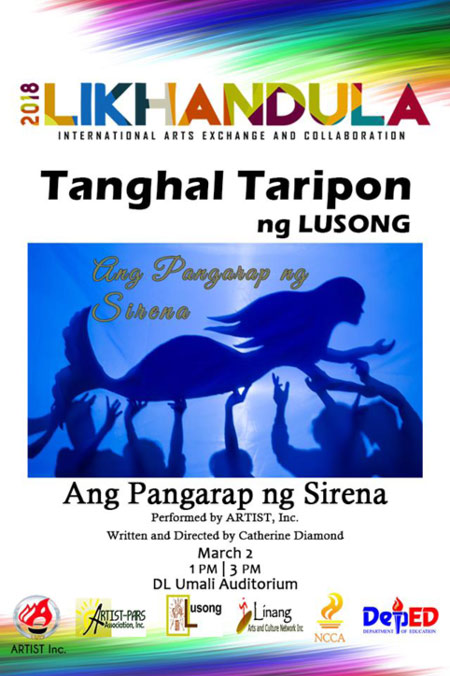 Photo Album |
The Mermaid’s Dream: Ang Pangarap ng Sirena, Artist Inc. Likhandula Festival, Los Baños, The Philippines The Mermaid’s Dream is based on the famous tale of Dyesebel, a mermaid, who, in the KETEP version is looking for her mother, when one of two anthropologists digging in a sea cave gets knocked out by a wave. Dyesebel rescues him and they fall in love. When the village fishermen find out that the marine biologist who was going to help them create a marine sanctuary is ill and cannot come, Dyesebel is persuaded to become human and pretend to be his son to help them set up the sanctuary but even as a man, she cannot disguise her love for the anthropologist. Meanwhile a developer is building an underwater hotel and invites an eccentric rich woman who loves sea animals to help him finance it. He promises her a live mermaid for her aquarium... Script: The Mermaid's Dream - English Script: The Mermaid's Dream - Tagalog |
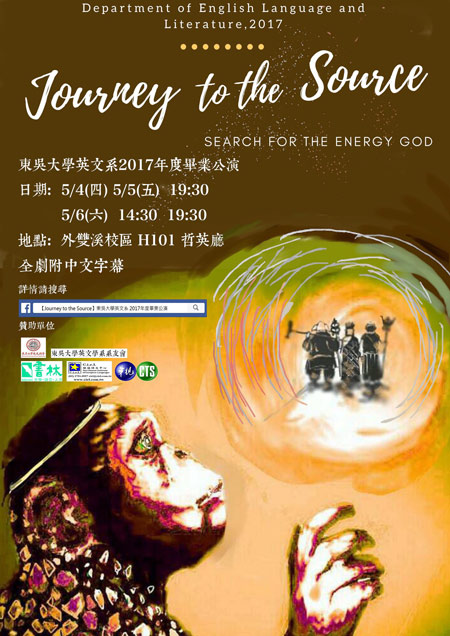 Photo Album |
Journey to the Source: Journey to the West (Xi you ji, 西遊記), Soochow University, Taipei. Journey to the Source is based on the 16th century Chinese classic Journey to the West featuring the monkey king, Sun Wukong. Accompanied by the traditional figures of Zhu Bajie (pig) and Sha Wujing (Sandy), the monkey king escorts not the monk seeking Buddhist scriptures, but a science nerd Linus to find the answer to Taiwan's energy needs after the island closes its nuclear plants. The team fights off demons from the coal burning black wind monster and fracking spiders, to considering the possibilities of geothermal, tidal and wave, LNG, pumped hydro, while Sun Wukong mistakenly takes wind turbines for Don Quixote's windmills and battles them. Without finding a perfect answer they realize Taiwan will need many solutions and constantly search for improving them. Script: Journey to the Source - English Script: Journey to the Source - Chinese |
| Ho Nguyet Co Thanh Nguoi: Ho Nguyet Co Becomes Human, School of Theatre and Cinema of Ho Chi Minh City. Ho Nguyet Co Becomes Human is based on the Vietnamese story Ho Nguyet Co hoa cao (Ho Nguyet Co Becomes a Fox) that is most well-known as a traditional play in tuong/hat boi and cailuong forms. In the original play, a fox through meditation turns into a woman who becomes involved with two warriors. When the latter tricks her into giving up her Jewel of Humanity, she devolves back into a fox in a grotesque dance. In the KETEP version, the ancient turtle in Hanoi's Hoan Kiem lake enjoins the fox to become human to persuade people to stop poaching rare forest animals. She works with a forest ranger to deceive a hunter and eagerly returns to being a fox. Script: Ho Nguyet Co Becomes Human - English Script: Ho Nguyet Co Becomes Human - Vietnamese |
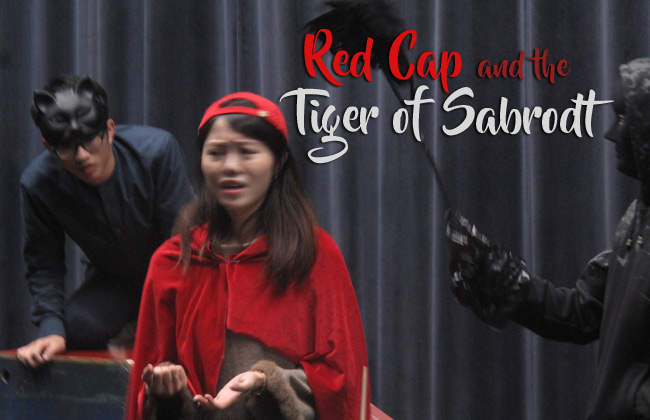 Photo Album |
Snow White and the Apple's Revenge; Red Cap and the Tiger of Sabrodt, Soochow University, Taipei. Snow White and the Apple's Revenge and Red Cap and the Tiger of Sabrodt, are two short plays based on early versions of the Grimm Brothers' fairytales. In the first, the Queen, Snow White's biological mother, whose desire for outer beauty drives her to persuade Snow White to grow genetically modified crops in the Dwarves' garden, including the recent GMO apple that leads to unforeseen genetic consequences. The second play reconsiders how the fairytale about the wicked wolf eating the grandmother retained human's fear of wolves even after the wolf was killed off, as the Tiger of Sabrodt was the last wolf in Brandenburg Germany exterminated over a century ago. The KETEP version shows the return of his grandson to the forests near Berlin, reopening the question of whether wolves and humans can coexist in proximity. Script: Red Cap and the Tiger of Sabrodt - English |
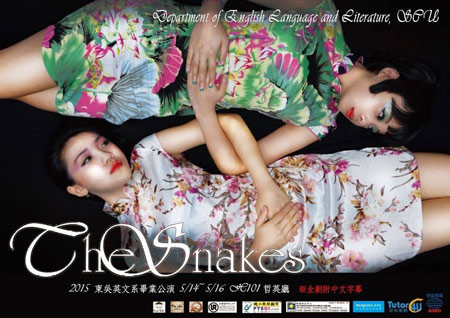 Photo Album |
Bai Shi Zhuan: The White Snake (The Snakes), Soochow University, Taipei. The White Snake, a famous 16th century tale, has been adapted for Chinese theatre and film many times. The animist deities, White and Green Snake, practice austerities to become human. The White Snake marries a pharmacist and has a child, but a monk condemns their marriage for its inappropriate relations between human and nonhuman. He separates them and captures White Snake under his temple. The KETEP script set the action in a non-specific time that includes both the 2003 SARS epidemic that began in the Guangdong animal markets and the current illegal wildlife trade in Southeast Asia for so-called Chinese medicine. Script: The Snakes - English Script: The Snakes - English and Chinese Script: The Snakes - Chinese |
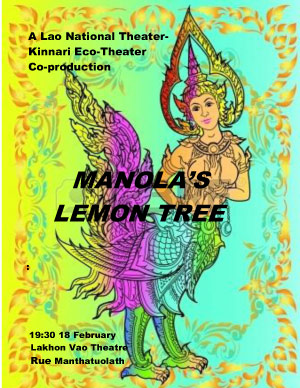 Photo Album |
Tonmai Manola: Manola's Lemon Tree, The Lao National Spoken Drama Theatre, Vientiane. Manola's Lemon Tree is based on the Lao version of the kinnari jataka, Manola and Sithon, in which the Kinnari princesses bathe in a forbidden lake and one of them—Manola—is caught by a hunter. He takes her to a king to be sacrificed but she is rescued by Prince Sithon. He wants to marry her but his parents object, and while he is fighting the avenging king, Manola escapes. He goes in search of her and after seven years he finds and marries her. The KETEP script addresses the devastation of the Kinnari forest homeland not by the highland tribes' slash-and-burn farming, but the clear-cutting by lumber companies, rubber and coffee plantations, and wildlife poaching. The KETEP includes tribal characters expressing their frustration at the injustice. In the original Lao story, Sithon has a magic lemon that helps overcome obstacles and so Manola plants a lemon tree as a symbol of their determination. Script: Manola's Lemon Tree - English Script: Manola's Lemon Tree - Lao |
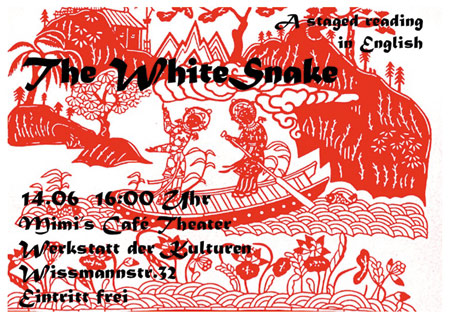 Photo Album |
Bai Shi Zhuan: The White Snake, Staged reading at Werkstatt der Kulturen, Berlin. Script: The White Snake - English |
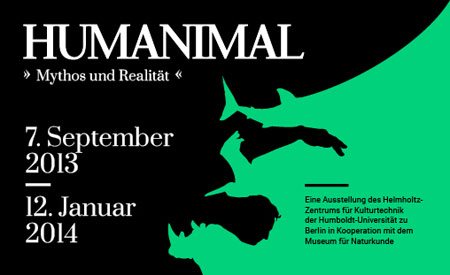 Photo Album |
Call Me Manora, Staged reading in conjunction with HUMANIMAL at Tieranatomisches Theater, Humboldt University, Berlin. Call Me Manora is a contemporary adaptation of the Thai version of the kinnari jataka, one of the 547 jatakas, or Buddhist "rebirth stories." They are a fusion of Indian tales and local animist myths with one of the characters representing the Siddhartha Gautama before he became The Buddha. The original story of Manora, a kinnari princess, tells of her adventures and love with Prince Suthon, who is The Buddha's precursor and the key figure in the region's Manora dance. KETEP's contemporary adaptation revisits their romance, but also incorporates hybrid animal-woman deities from around the world. They protest their inability to cohabit with humans during the avian flu virus "epidemic" and discuss the usefulness of self-sacrifice in times of emergency. Script: Call Me Manora - English |
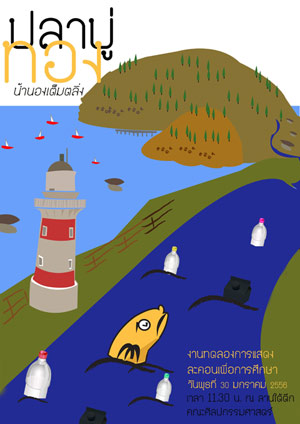 Photo Album |
Pla Boo Thong: The Golden Fish in Flood Time Thammasat University, Rangsit, Thailand. The Golden Fish, a well-known Thai folktale, was adapted to address the 2011 flood in central Thailand, including Rangsit, just north of Bangkok, where Thammasat is located. The original tale tells of a fisherman with two wives, each of whom has a daughter. His first wife drowns when she tries to protect a golden fish that they have caught. He takes the fish home to eat but her daughter goes in search of her mother and discovers she has been turned into a golden fish. His second wife and her daughter eat not only the first golden fish, but the mother fish as well. The good daughter rescues a single scale, plants it and it becomes a golden tree. With the use of "rubbish puppets," the KETEP performance unveiled the causes of the flood and emphasized the ubiquitous plastic and Styrofoam rubbish that exacerbated flood damage in all the low lying communities. Script: The Golden Fish - English Script: The Golden Fish - Thai |
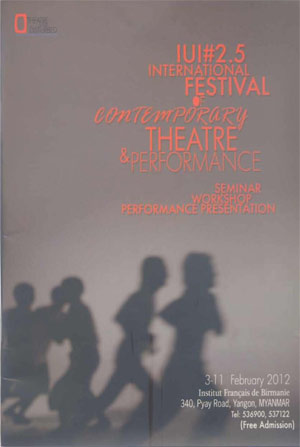 Photo Album |
The Philosopher's Plastic Stone, iUi#2.5 International Theatre Festival, Yangon. KETEP's The Philosopher's Plastic Stone is adapted from "Why There Are so Many Pagodas at Pagan" that involves a Monk cum astrologer/alchemist (aka zawgyi in Myanmar) who depletes the King's treasury in his search for the Philosopher's Stone that will turn base metals into gold. To punish himself, he puts out his eyes and tosses the stone into the latrine that his Assistant later discovers is on fire. To see what has occurred, he tells his Assistant to buy some animal eyes in the market but the Assistant can only find one bull's eye and one goat's eye, so the monk becomes known as Monk Goat-Bull. He takes the stone from the latrine, and after he turns all the pots in Pagan into gold, the people become rich and build many temples. The KETEP version combines the Burmese folktale with the Greek myth of King Midas, but instead of gold, every object he touches turns into plastic. At first the King and all the people are pleased with the Monk's new convenient, cheap, light material, but when the King's food, the Princess and the Assistant are turned into plastic, and the rubbish piles mount, Monk Goat-Bull throws away the magic stone and begins a new mantra. Script: The Philosopher's Plastic Stone - English Script: The Philosopher's Plastic Stone - Burmese |
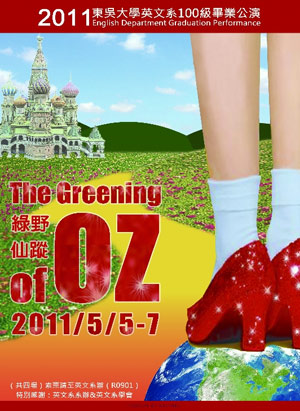 Photo Album Video |
The Greening of Oz, Soochow University, Taipei. The Greening of Oz is an adaptation of the 1939 screenplay, The Wizard of Oz, which easily lends itself to an ecological interpretation. Dorothy and her dog Toto live with her Aunt Em and Uncle Henry on a small family farm that is being threatened by the encroaching Gulch Factory Farms. When a tornado comes, Dorothy and Toto are whirled away to Planet Oz where the Wicked Witch is turning the whole planet into plastic. Dorothy meets the Scarecrow who can't scare crows because they've died from insecticide; a Tin Woodman who lost his heart when his forest was clear cut; and a Lion who is cowardly ever since trophy hunters with powerful rifles killed his family. The Wizard promises to help them all and to get Dorothy back to Earth, which she can only do once she fully appreciates it. Script: The Greening of Oz - English |
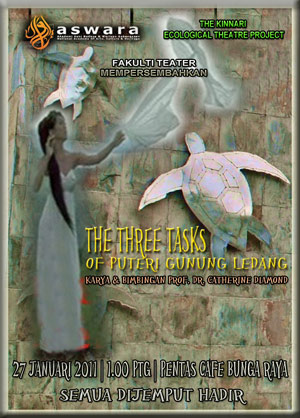 Photo Album |
Puteri Gunung Ledang: The Three Tasks of Princess Gunung Ledang Akademi Seni Budaya dan Warisan Kebansaan (ASWARA), Kuala Lumpur. The legend of Puteri Gunung Ledang (the Princess of Mount Ledang) is known to all Malaysians. In 2004, a film version (PGL) that was then remade for the Kuala Lumpur stage in 2006 became the country's most popular musical. Although there are many variations, they all involve the 15th century Sultan Mahmud Shah of Melaka, who, desiring to marry the Princess, sends his loyal warrior Hang Tuah to fetch her from the mountain. She, unwilling to marry the Sultan, gives him seven impossible tasks, the last being the blood of his heir. The KETEP version comically adapts the love story between the Princess and the Sultan's emissary, Hang Tuah. The princess gives the warrior three "impossible" tasks for his master: to stop the illegal sale of sea turtle eggs in Malaysia; to stop the uncontrolled growth of palm oil plantations destroying forests in Borneo; and to decrease the plastic rubbish clogging the two rivers in Kuala Lumpur. Script: The Three Tasks of Princess Gunung Ledang - English Script: The Three Tasks of Princess Gunung Ledang - Malay |
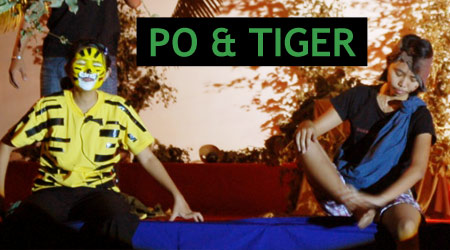 Photo Album |
Po and Tiger, iUi#2 International Theatre Festival, Yangon. KETEP's Po and Tiger was adapted from a Burmese folk tale "Master Po and the Tiger," which is astonishingly critical of human's abuse of the natural environment. It required little alteration to emphasize the plight of the tiger that is on the verge of extinction in the Burmese forests. A village boy, Po, becomes best friends with orphaned Tiger in the forest, but when full grown, Tiger steals chickens from the village. Po tries to dissuade him and refuses to help, but Tiger persists, and is caught and encaged. He persuades Po to release him and when he does, Tiger wants to eat him. Po says such ingratitude is unacceptable, but Tiger insists that they let the forest judge. They ask Banyan Tree and Buffalo Skull that both respond that men have failed to show gratitude and tell Tiger to eat Po. Only clever Rabbit manages to trick Tiger back into the cage. The KETEP version allows Tiger to speak about the services he renders to the villagers, and the consequences of forest depletion that drove him into the village. The play has six different endings, allowing the audience to decide the most appropriate to assure Tiger's existence in the future. Script: Po and Tiger - English Script: Po and Tiger - Burmese |
